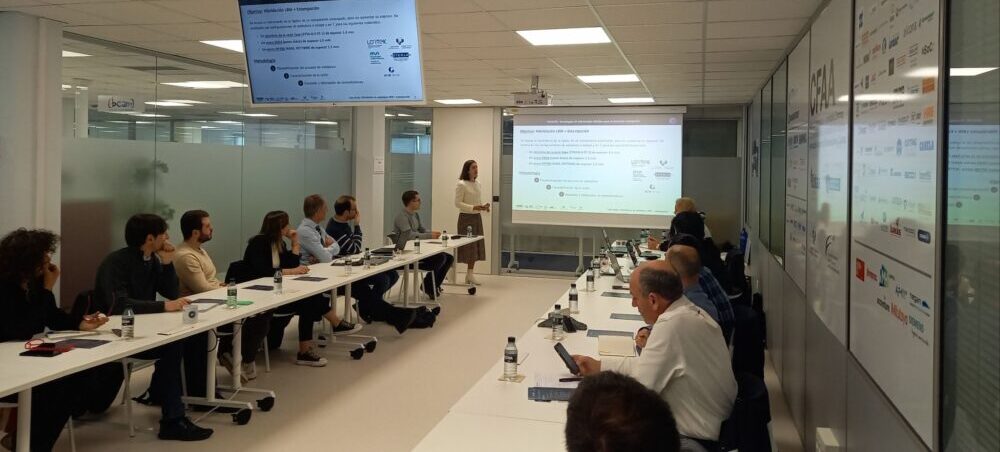The IMAGINE project team, led by the AZTERLAN Metallurgy Research Centre, has developed hybrid casting, hydrosolidification, forging, stamping, additive manufacturing and welding processes in order to develop components with complex geometries and specific characteristics, at more competitive costs. Once the project has finished, the hybridized technologies and the demonstrators manufactured with them have been presented in a meeting open to representatives of the industry.
Since 2021, the IMAGINE project consortium has worked on the hybridization of different manufacturing technologies in order to develop more flexible processes and components with complex geometries and advanced features. Once the project has finished, the consortium has presented the results of the hybridized technologies. The presentation event took place at the CFAA (Zamudio) on April 20 and brought together professionals from various industrial sectors.
The agents participating in the project were “satisfied with the results obtained, the collaboration model that we have maintained during the project and the learning obtained throughout it.” In addition, as Dr. Ana Isabel Fernández Calvo, AZTERLAN researcher and technical manager of the project, explains, “we have met the main challenge that we set ourselves when we started this project: obtaining parts in which the union between the different hybridized technologies was not a critical point for its performance. After carrying out the corresponding tests, we have been able to verify that the two hybrid technologies offer the same metallurgical properties and that the joining points between both technologies do not present weak points”.

Session to present the results of the IMAGINE projet
Case studies and demonstrators developed within IMAGINE
1) Case study HYDROSOLIDIFICATION HYBRIDIZATION + FORGING: “Hydrosolidified aluminum preform 6082 subsequently forged at high temperature”
- See case study
- Participating agents: AZTERLAN | MGPE | FCIE
2) Case study HYBRIDIZATION OF LASER WELDING + STAMPING: “Steels and aluminum alloys welded by laser in a “T” or overlap + cold stamping maintaining the reinforcements”
- See case study
- Participating agents: MGEP | LORTEK | UPV/EHU | FCIE
3) Case study HYBRIDIZATION OF FOUNDRY + ADDITIVE MANUFACTURING: “Aluminum alloys to obtain areas with improved properties and/or new functionalities, and simplification of mold filling”
- See case study AlSi7Mg to the investment reinforced by additive in WAAM
- See case study Hydrosolidified 5356 alloy reinforced by L-DED wire
- Participating agents: EIPC | LORTEK | TEKNIKER | AZTERLAN
4) Case study HYBRIDIZATION OF FORGING + ADDITIVE MANUFACTURING: “Superalloys: forged IN718 base + additive to add characteristics and improve functionality”
- See case study L-DED powder: IN718
- See case study L-DED powder: Astroloy
- See case study L-PBF
- Participating agents: CEIT | LORTEK | MGEP | UPV/EHU
The IMAGINE project consortium is made up of 4 technology centers, 2 universities and 2 R&D business units, with complementary areas of specialization and benchmarks in the field of advanced manufacturing in the Basque Country: BRTA members AZTERLAN (project leader) , CEIT, LORTEK, and TEKNIKER, the EIPC RESEARCH CENTER and FUNDACIÓN CIE I+D+i business R&D Units, the Department of Mechanical Engineering of the UPV/EHU and the Research Group of Advanced Materials Forming Processes of MGEP. The project also has the collaboration of an Industrial Contrasting Committee made up of leading companies in the Basque Country with experience and manufacturing capabilities in one or more of the hybridization technologies under study.
With an estimated duration of two years, the IMAGINE project, Manufacturing for Intelligent Industry (hybrid manufacturing technologies for intelligent industry), is funded by the Department of Industry of the Basque Government through the Collaborative Research Aid Program in strategic areas – Elkartek Program. Reference: KK-2021/00120. It supposes a strategic bet of all the members of the consortium, which “we are very aligned with the important potential of technological development and application, that the results of IMAGINE can offer us”.

